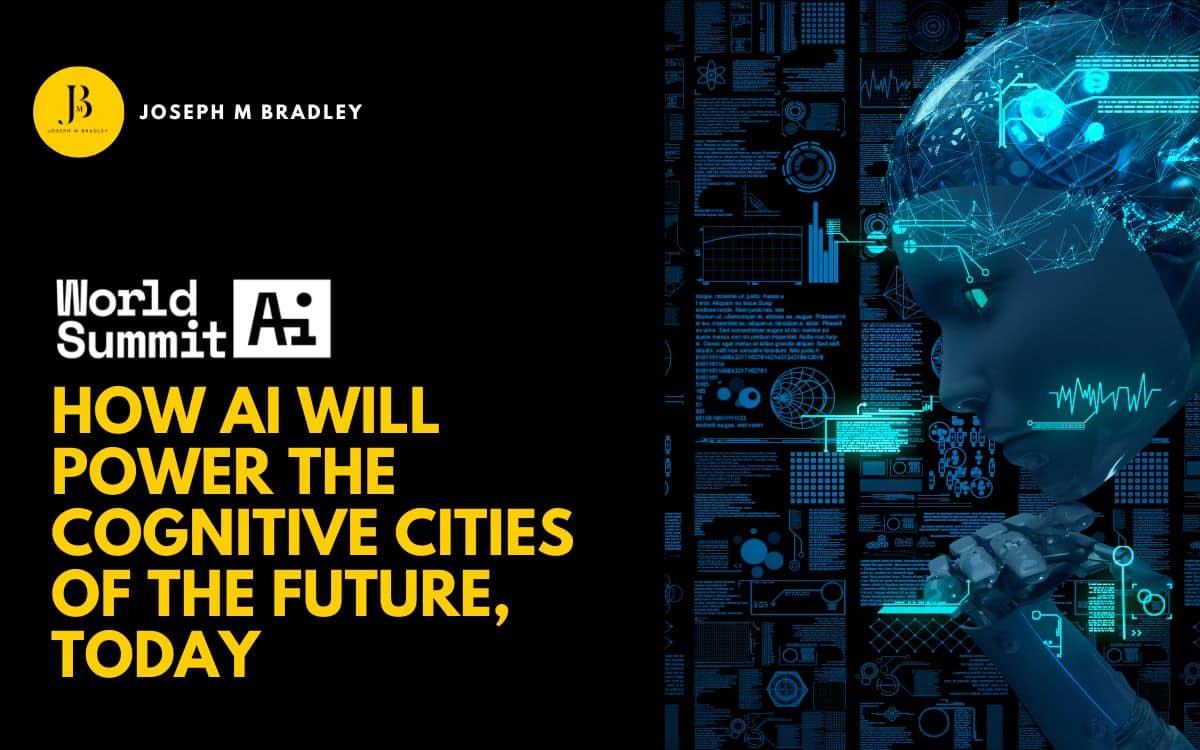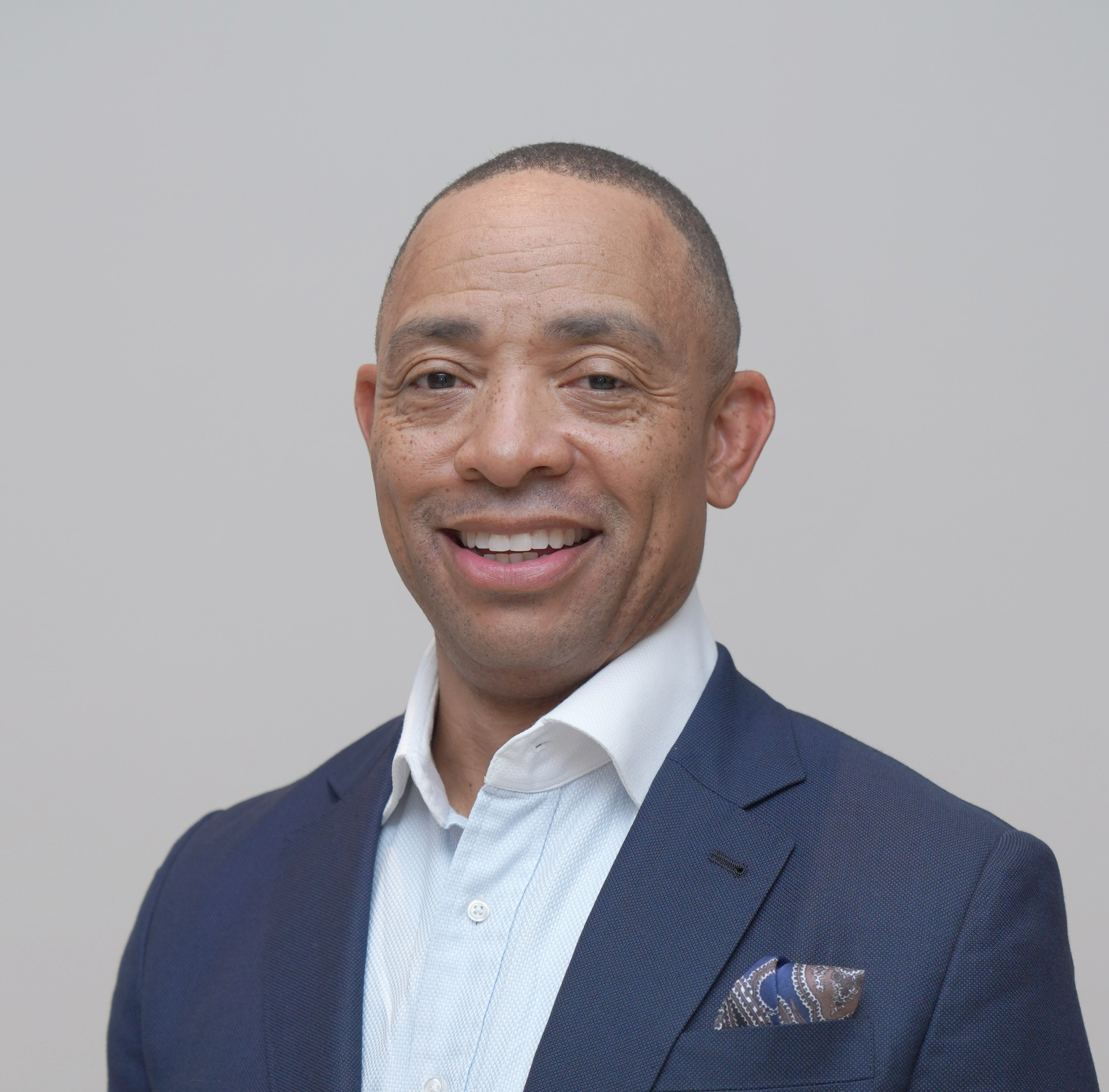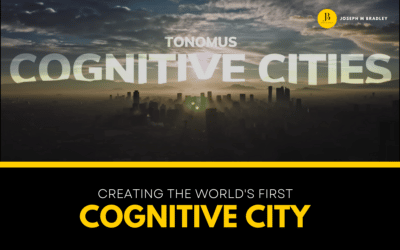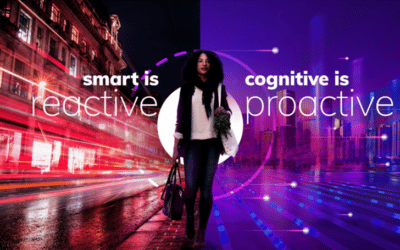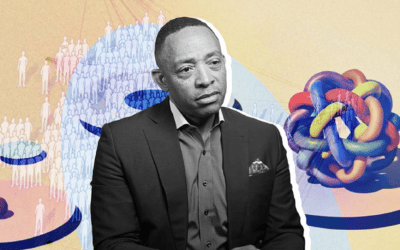In his keynote address at the World Summit AI, Joseph Bradley discusses the importance of AI innovations to develop predictive, cognitive technologies for the future and shared the TONOMUS cognitive blueprint to build the infrastructure layer to achieve digital air.
Transcript
Thank you very much. It is great to get an opportunity to talk to you today, especially with all these great AI professionals and smart folks in the audience really focused on the future and where we’re headed.
Before I start, I want to talk to you about the past. I want to go to January 29th when the world was calm. In fact, we had just gotten done with our New Year’s resolutions. We were talking about all the great things we were going to do. Then all of a sudden, everything changed.
You had playgrounds with no children.
You had tourist locations with no tourists.
You had airports with no travelers.
And we in the tech community said, “Don’t worry.” We said, “We got this”, right? We’ve gone to all these great conferences, and we’ve talked about digitization and agile business models and next-generation collaboration. And what did we deliver?
When the world stopped moving, stopped being able to say “hello”, we said, “We got it. Oh, sorry. You’re on mute. No, no, no. You’re on mute. You’re on mute.” That was the experience that we delivered. And when you think about the cost, what’s at stake? What do we lose? Well, if you think about children, six months to two years of education has been lost. Think about the economic impact, 4 trillion dollars. What about mental health – 30%, 35% increase. These are the things that we saw, and we experienced.
When you think about where we’ve been and what we’ve done, it’s our call to action as AI leaders, as technologists, as a technology community to change. And we have to understand that real time – what we always thought was so great – real-time information is too late. The damage is done.
Real-time in smart cities meant that we were working with one-time transactions, stagnant learning. We have to move to a much more relationship based, celebrated learning model. We’ve worked many, many, many months, many years on creating what we call the “cognitive blueprint”. This is all really simplified, but this is what we’ve built and are building – an infrastructure layer provides you with digital air. You walk into a place or building, and you have connectivity. You get to the core AI services, you can think of those as more of what Netflix is to movies, kind of like what core AI services are to data. You have all these great applications on top.
Now, here’s the thing. That’s the easy stuff. What’s really, really, really hard is what we call the “experience paradigm”. That’s what we have to solve. You see, algorithms are great, excellent at solving efficiency problems, but the world’s problems today are far more than efficiency.
Think about you going to a grocery store, and you’re waiting in line, and you’re checking out. You’ve got two choices: there’s this highly efficient self-checkout to the left, highly efficient. And then there’s the people checkout to the right. Four or five unmanned machines to the left. And one or two people over here to the right. Where are you going? Raise your hand. Who’s going over to the automated self-checkout? Who loves that? Okay, now who’s going to talk to the people to the right? Oh, very interesting. Very interesting. We’ve got a Generation Z and a Millennial audience. That’s good. Or those that want to be Generation Z and Millennials. Why is that? What’s the difference between the two? Well, if you want to be more efficient, you can go to the left. There’s nothing wrong with that. But if you’ve been locked in your room for the last year and a half, you haven’t interacted with somebody, you want to go to that right. Why? Because they may tell you,” Hey, how are you doing today?” An exchange, human exchange. Wow. Or they may give you a recommendation on a thing you’re purchasing.
This idea, the experience paradigm is critical. How do you solve for what is human? What is feeling? When you think about this, there are three golden rules that if you want to solve for this paradigm you have to address.
Let’s talk about the first one. The first one is very simple. Without trust, you have no data. Without data, you cannot create value. You need to manage trust with an end-to-end consent manager platform. Love the question when you talk about the Cognitive City. What are you going to do, or how are you going to get us to give you our data? Newsflash: you already do. You think you’re clicking on that website, it says consent, accept, you just see the tip of the iceberg. You don’t know what you just consented to that lies beneath it. The issue is exposing you to who has your data, how is it being used, and giving you a common architecture a way to understand it all. We know you don’t know all the things about medical data and should you release it or not. You’ve got to be able to get an expert opinion, whether that’s AI or whether you simply choose to defer to one of your doctors and accept what they have.
Golden rule number two: AI. AI is a people-first venture; it’s a people business. Remember you get trust, but where do you get trust from? You get trust from people. They give you data. Data creates value. Why do I say that? Because if you are in this room, you have to understand the difference that is required between being in a diverse room, a diverse community, a diverse world, and one that is inclusive. Diversity is simply the potential to create value. You have a diverse group of people in the audience. But if there is no interaction, if there is no full participation, no value can be created. When you think about AI, you must talk about how it works if you are without sight? How does it work if you cannot hear? How does it work if you have a disability? These are the things that have to be interwoven into the fundamental psyche of what we are developing.
Okay, so now if you’re with me that you have to drive an inclusive environment that is really people centric. By showing hands again, how many Millennials do we have in the audience? Millennials. Okay, very good. How about Generation Z? Okay. And just people who want to be Millennial or Generation Z. Okay, that’s better. I’m going to need the Millennials and Generation Zs to help us out on this one now. I’m going to need you to help us out, because I just told you, by definition, you have to create an inclusive world. Well, that means, by definition, the physical world is limited. There are only so many people you can get to engage when in a physical setting. Therefore, the physical is an add on to the digital. I’m not saying you’ll get rid of the physical world; no, of course not. But what I’m telling you is when you think about creating something physically, that should be to enhance the digital. You need to drive inclusion; you need to reach everybody. But, by definition, the physical world is limited. I can only have so many people in this auditorium. There’s a whole lot of people that want to participate. Right? You understand where I’m going? You know, this intuitively. You think about financials, the assets of companies. What’s the number one asset on their balance sheet now? Is it physical assets or intangible? Intangible? 90% of the assets are intangible assets. Think about some of the top companies, they don’t build a building first. They created a digital platform and then they started moving into stores to get you to augment the buying experience. You know this inherently. But it’s a little difficult to get your arms around, to get your head around.
So those are the three golden rules. How do we make this real? I’m going to introduce you to one of my favorite people on the planet. His name is Malcolm. Malcolm is my six-year-old nephew. If I mention metaverse to Malcolm, he gets crazily excited because to him, metaverse is a game. When you talk to a lot of people and you mention the word, metaverse, they also come up with great gaming, you know, AR, VR, kinds of stuff. That’s great. But I just told you that by definition, the physical is an add-on to digital because you need to drive a full set of participation and inclusion. To us at TONOMUS, the metaverse is not a game. The metaverse represents the potential for the world to continue to move, which is what COVID took away from us. When I say “the metaverse”, I’m specifically talking about an unstoppable way for humanity to connect, to feel, to learn, in other words, for us to be human. Now, there are a lot of examples of this. I’m just going to go through a couple.
Let’s talk about the first one; I love this one: Eternal Notre Dame; amazing church, amazing architecture, beautiful building. And when the fire happened, some really creative people said, “We still want the world to engage. We want to be able to ensure that we can touch people while this is being constructed.” So, they created a metaverse experience to allow you to visit and see what it was like during construction. They actually paid for 30% of the rebuilding this way. They gave you that inclusive experience. This is a great example of a practical application of what I’m talking about. And this was right in the middle of COVID, I mean, right in the middle of it.
The largest venue, the biggest concert in the world can hold 250,000 people. That’s it. Remember, we’re all probably into month number four still trying to figure out what we could do in a house that’s creative without going outside. Travis Scott said, “Hey, I got an idea. How do I put on a concert that’s bigger than 250,000 people? He said, “No problem; I’m going to use a metaverse experience, and I’m going to put on a concert like Fortnite. Guess what happens? He went from 250,000 to 27 million people engaged in that concert. That is the power of what I’m saying.
To bring it, even closer to home, let’s talk about The LINE. The LINE is a marvel, 170 kilometers long, 500 meters tall, and 200 meters wide, with 9 million residents in a footprint only 2% the size of a traditional city. It’s a great marvel of technology. How are we building the line? Well, one of the core elements in The LINE is you can walk to every aspect of The LINE all within 5 minutes because of vertical living. How do you know that if you haven’t done it? Well, we’ve done it. How can you do it if you haven’t built it yet? Well, we’re using metaverse technologies to build it out, to model it as we create. These are the things that are possible as we move beyond that. Then you get into NEOM as the first multiverse city, merging physical and digital together, allowing you to connect not one to one, but one to many, in creating that type of value.
Now let’s talk about the next evolution. That’s great; one to many, but what’s the next step? Education. Now, here’s the interesting thing about education. When you think about what’s happening, especially when you think about the youth and the kids, when they go to a particular program, they are struggling to be engaged around that program. They’re struggling with the concept. You have kids who sit in school and it’s hard for them to pick up the lessons. I learned this the hard way. I had an opportunity to watch my six-year-old nephew, Malcolm. My sister forgot to tell me that when she said to take them to school – I was thinking of a traditional school still in my mind – that I was about to experience what many young parents have experienced. I was way past my time where you have to occupy a six-year-old kid in front of a TV screen, trying to engage him in video conference-based education. And oh, by the way, we’re going to do that for 45 minutes at a time. The average attention span of a kid is only 2 to 3 times their age. That’s it. With a six-year-old kid, you got maybe 12 minutes. You’ve got to be working to get those 12 minutes. Right? You got to work. So, I took that same kid and I said, “Okay, now, Malcolm, we’re going to play a game.” Let me tell you, this is what happened. He was so happy. All of a sudden, that kid couldn’t focus, he was like a zombie, so into it, understanding it. The ability to gamify, or, in other words, to make every educational experience like a field trip, a one-way direction that we’re moving into.
Being able to get talent teleportation. It costs us $64 billion a year because we get the wrong advice because we can’t find that right person to give us the information that we ultimately need. Another great metaverse application that we’re seeing as we move on and one of my favorites is Mixed Reality Immersion. People ask me, “How are you going to get someone in New York to come to NEOM? What does that look like? Are they just going to get on a plane and travel 25 hours to see if this is a cool place? No. So probably what happens is they hear about NEOM, they think it sounded cool but, I don’t want to get on a plane, I don’t want to travel 20 hours. Where do I go? Let me go to this mixed reality X-verse that I’ve heard about. Let me get on this and then say, “Oh, great, I can buy some NFT content, I can create my digital apartment, I can make it and shape it how want it to be.” You’re engaging with people that are similar to your interests. You’re loving it. And then all of a sudden, we give you a note, and we say, “Hey, guess what? We’re going to build the real thing.” We say, “Are you interested?” You go, “Oh, that sounds really cool. But you know what though, still man, that’s a long way to fly. I don’t know if I want to buy this thing, if I want to go to the next step. I want to upgrade my subscription so I can show up as a hologram.” So, I show up as a hologram, and now I get to see if that Joseph guy was right about the humidity. Let me talk to someone in the sales office. Is it really not humid? Those are the types of experiences that we can enable, and when you think about the monetization opportunities, remember this all happens because of the movement between physical and virtual. That’s where the monetization happens. The metaverse is not physical, it’s not digital. It’s a combination of both. It’s not one website, not a physical environment, it’s the interaction between the two that creates the value, that creates the value opportunities.
My wife and I recently completed a trip to Dubai. How many have been to Dubai? Very good I got a couple that has been to Dubai. Have any of you worked for Gucci? Does anybody work here for Gucci? If you do, you’re going to have a really good quarter because my wife is going to make sure you had a really good quarter. Let me tell you, if you look on the income statement, I’m sure there is going to be a little note that says, “Laurie Bradley visited Dubai and went to your store.” So, here’s the thing. Not only did she buy physical items. What did she buy? She bought the digital versions. Gucci is a great thing. They have the real purse you can buy and then for 20% more, you get to own the NFT of that purse, and people are buying it. They’re buying it! This is the kind of opportunity that we’re talking about – engaging.
If you want to buy into this notion, that the metaverse is a way for us to move, to connect – it’s much bigger than a game. How do you get started? Three ground rules.
Number one: one experience at a time. Don’t try to create the whole metaverse world. Come up with 25 experiences. Focus on one and then go from there. Build from there. Understand, it’s a duality of the physical and the virtual that make a metaverse. You can’t just create a video game and say, “That’s a metaverse.” No. You can’t just build this cool city and say, “That’s the metaverse.” No. The metaverse has to have interaction between the two.
The last one is probably the most important. This notion of diversity and moving to inclusion means that everything the metaverse touches becomes a platform by definition. If you apply the metaverse to a city, that city no longer follows traditional economics – it follows platform economics. That means the more people participate, the more valuable it is. That means you have an opportunity to ingrain, to infuse inclusion and eliminate divides in the beginning, because that is what drives value for the platform. It is so fundamentally important.
It’s critical, and the reason I’m talking about this in an AI conference is because, quite frankly, we as world technologists, we as people, we as humans, have gotten far too comfortable with despair. We even stopped dreaming. We stopped. In fact, it’s not even cool anymore. We’re okay with these pictures. We’re fine with it. Like it’s just another day; we’re way too comfortable with despair. It’s become a normal day of life. You can’t accept this anymore. You’ve got to move beyond this. When you think about where we’re headed and what’s happening, there has always been and will continue to be a very, very fine line between radical innovation and wishful thinking. I need you to push that line. I need you to go right up to the edge of that line because that’s who we’re doing it for. That’s what we’re doing this for. It’s not a game. It’s not buzzwords. We’re doing it for the next generation. That’s what we’re trying to create.
When you go from this conference, I don’t want you to worry about what you don’t know.
I want you to be bold.
I want you to be courageous.
I want you to challenge each and every day what this world tells you to be true.
Be a change maker.
Go make it happen.
Thank you, guys.

